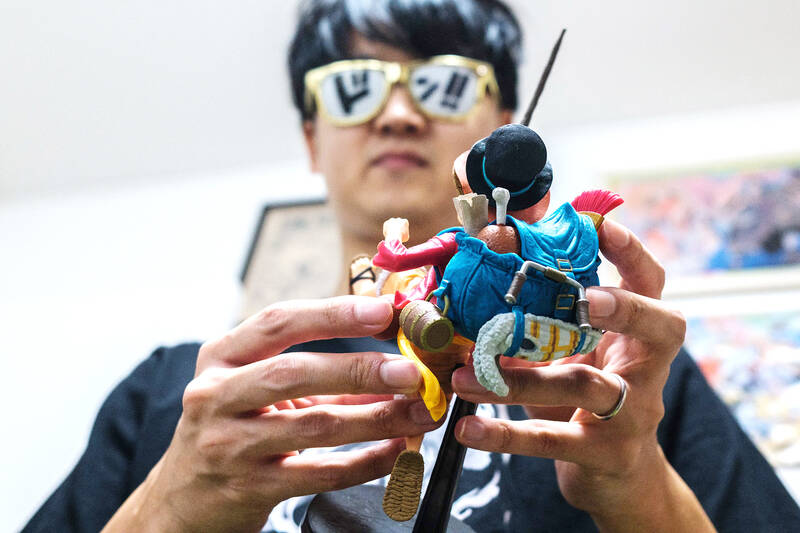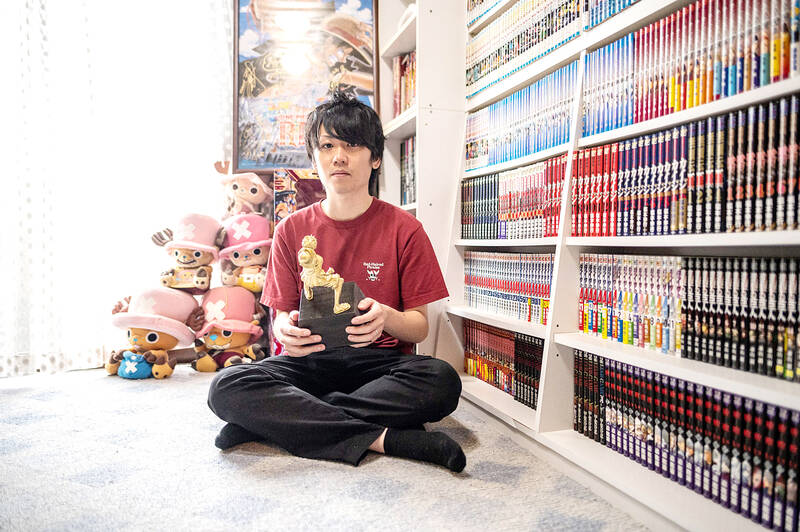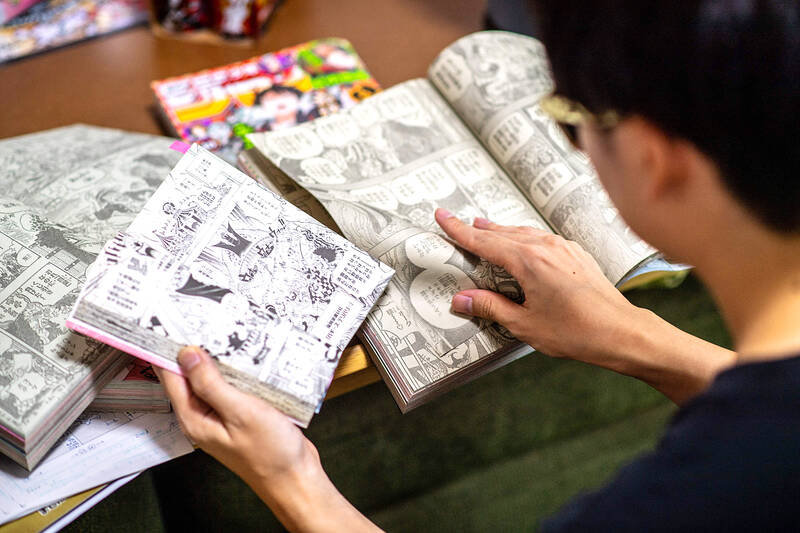Shohei Sato’s devotion to the pirate manga One Piece culminated in a wedding themed on the series, and he’s not the only superfan obsessed with its intricate plots and swashbuckling characters.
The Japanese comic-book saga began 25 years ago and is one of the biggest-selling mangas of all time, with more than 500 million copies sold globally.
It follows straw hat-wearing Monkey D. Luffy and his team as they hunt for treasure, and has grown into a sprawling cultural franchise — now riding even greater waves of popularity thanks to a new hit film and an upcoming live-action Netflix series.

Photo: AFP
Since childhood, 29-year-old Sato estimates he has spent “well over 10 million yen (US$67,000 at current rates), if not 20 million” amassing merchandise and crisscrossing Japan to attend One Piece events.
So the office worker’s friends weren’t surprised when he and his bride Junna had a pirate-ship cake at their wedding in July and posed for photos beside a giant poster of Luffy and his gang in formal attire.
“They told me, ‘Shohei, it was so you,’” Sato said at his home in Tokyo, where plush toys of the reindeer-like character Chopper sit next to bookshelves packed with One Piece volumes.

Photo: AFP
“I’ve lived my whole life alongside One Piece, so I wanted my wedding to honor it.”
The latest movie in the franchise, One Piece Film: Red, was released in August and is already Japan’s highest-grossing film this year.
Sato has seen it 21 times.

Photo: AFP
The film has also been a hit abroad, especially in France, while fans came out in costume for a huge Times Square ad campaign ahead of the US release in November.
‘KNOWLEDGE KING’
Inspiring dialogue, clever foreshadowing and relatable characters — author Eiichiro Oda is said to shed tears as he draws them crying — are often cited by One Piece superfans as the reason for their infatuation.
The manga’s plots are so intricate that publisher Shueisha holds a yearly quiz in which tens of thousands of fans compete to become its “knowledge king.”
Sato once came in 10th, winning a golden trophy.
Another regular contestant, whose record is 15th place, is a systems engineer who goes by the online moniker Arimo.
Every night, after tucking his son into bed, the 32-year-old reads One Piece in his study, which is decorated with illustrations from the series.
Even the walls of Arimo’s toilet are plastered with pages from the manga, and the geography-lover has crafted his own globe to map the islands and oceans explored by Luffy.
“The One Piece world is so meticulously thought-out, I sometimes feel like there’s truly an alternative universe like this somewhere,” Arimo said.
One Piece is serialized in the weekly Shonen Jump magazine, which is aimed at teenage boys.
But its exaggerated humor, adrenalized action scenes and hundreds of varied characters appeal to a far broader readership.
‘ONE PIECE IS MY ENERGY’
Natsumi Takezawa, 34, said she had “forgotten One Piece is supposed to be a boy’s manga,” because it “strikes a chord with all generations.”
She works part-time and reads One Piece for a little relaxation after picking up her five-year-old daughter from nursery, making dinner, bathing and playing with her, before finally putting her to bed.
“Without One Piece, I might feel drained,” she said. “I might be too exhausted by chores to do anything but sleep. That’s all my life could’ve been about. One Piece is my energy.”
Takezawa says the manga has even helped her with grief.
Seeing the bawling Luffy realize “I still have my friends” after the death of his brother resonated deeply after she lost a close friend this year.
“What kind of experience does a person have to go through to be able to draw such a powerful scene?” she said.
The One Piece saga entered its final arc in July.
Oda said in 2019 that he wants to wrap up the story “within five years,” technically leaving little time until its conclusion.
Sato thinks “another seven to eight years” would be a reasonable bet, however.
“One Piece is part of my life now, so I definitely want to see it through to the end,” he said.
“Until then, I refuse to die.”

Nov. 11 to Nov. 17 People may call Taipei a “living hell for pedestrians,” but back in the 1960s and 1970s, citizens were even discouraged from crossing major roads on foot. And there weren’t crosswalks or pedestrian signals at busy intersections. A 1978 editorial in the China Times (中國時報) reflected the government’s car-centric attitude: “Pedestrians too often risk their lives to compete with vehicles over road use instead of using an overpass. If they get hit by a car, who can they blame?” Taipei’s car traffic was growing exponentially during the 1960s, and along with it the frequency of accidents. The policy

While Americans face the upcoming second Donald Trump presidency with bright optimism/existential dread in Taiwan there are also varying opinions on what the impact will be here. Regardless of what one thinks of Trump personally and his first administration, US-Taiwan relations blossomed. Relative to the previous Obama administration, arms sales rocketed from US$14 billion during Obama’s eight years to US$18 billion in four years under Trump. High-profile visits by administration officials, bipartisan Congressional delegations, more and higher-level government-to-government direct contacts were all increased under Trump, setting the stage and example for the Biden administration to follow. However, Trump administration secretary

In mid-1949 George Kennan, the famed geopolitical thinker and analyst, wrote a memorandum on US policy towards Taiwan and Penghu, then known as, respectively, Formosa and the Pescadores. In it he argued that Formosa and Pescadores would be lost to the Chine communists in a few years, or even months, because of the deteriorating situation on the islands, defeating the US goal of keeping them out of Communist Chinese hands. Kennan contended that “the only reasonably sure chance of denying Formosa and the Pescadores to the Communists” would be to remove the current Chinese administration, establish a neutral administration and

A “meta” detective series in which a struggling Asian waiter becomes the unlikely hero of a police procedural-style criminal conspiracy, Interior Chinatown satirizes Hollywood’s stereotypical treatment of minorities — while also nodding to the progress the industry has belatedly made. The new show, out on Disney-owned Hulu next Tuesday, is based on the critically adored novel by US author Charles Yu (游朝凱), who is of Taiwanese descent. Yu’s 2020 bestseller delivered a humorous takedown of racism in US society through the adventures of Willis Wu, a Hollywood extra reduced to playing roles like “Background Oriental Male” but who dreams of one day